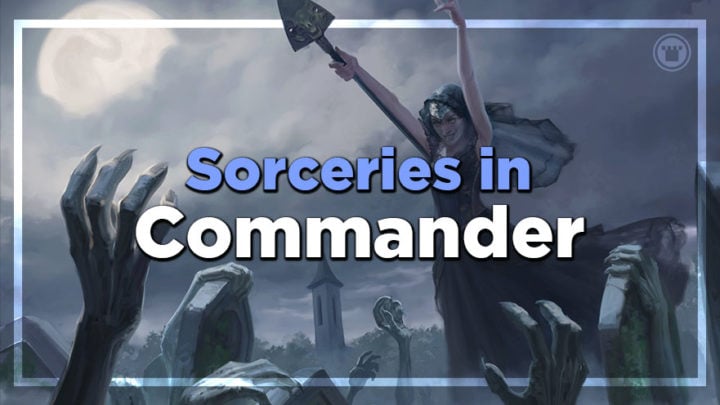Sorceries always play second fiddle to instants when it comes to Commander, and it’s really no surprise why. In an increasingly fast and swingy format, what can sorceries offer? And what tools does Midnight Hunt give us?
Sorceries are Bad in EDH
Let’s face it — sorceries are just bad in EDH. Yes, there are some great sorceries, and yes, every deck plays them, but they’re a little awkward and unwieldy. They’re the equivalent of wielding a greatsword in a narrow hallway, basically. You might be able to get by with them, but they’re rapidly outclassed by blades or daggers that offer greater maneuverability and speed.
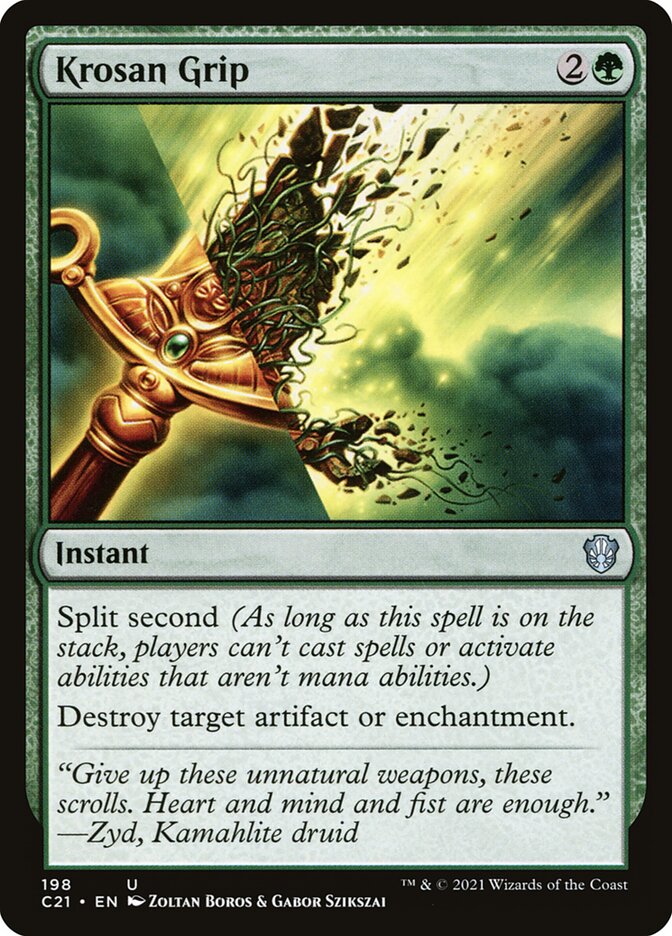
First up, they’re too slow. You’ll prefer instants where possible because they allow you to interact at the right moment. Instants can help remove a combo piece while another is on the stack, stopping an opponent from winning the game. Sorceries, meanwhile, have the disadvantage of forcing you to wait until you untap. By that point, it might be too late.

Sorceries also mean you end up tapping out during your turn. This means you won’t have mana open to react to other plays, and you’ll often lose a lot of tempo by playing a sorcery. In the opening stages of the game, this is less pronounced, but as the game goes on, playing predominantly sorcery-speed removal instead of saving it as a political tool at instant speed can lose you a lot of tempo.

Incidentally, this also stops you from holding up other ways to use your mana, should the game take a different turn. Say an opponent ends up using their removal on the same thing you were going to — this lets you use that mana to either counter a spell, draw some cards, or even just remove something else. You get more information by playing cards as late as possible.
Sorceries are Necessary
While sorceries are naturally inferior to spells that can be cast at instant speed, they’re also necessary in the format. Without good ramp, board wipes, and card draw, many decks would struggle to perform. For playing during your main phases, you can get far more than you could from an instant.
But what makes a good sorcery in Commander?
- Cost/Rate — Sorceries are often cheaper than instants for the same effect. In exchange for playing during your own turn, you can spend less mana. An instant-speed board wipe like Rout costs seven, where Wrath of God is only four.
- Effect — Declaration in Stone exiles a creature for two mana, but can exile a board full of the same creature or a board full of tokens. In many ways, it’s worth much more than the one-mana increase from Path to Exile. Similarly, Winds of Abandon is Path to Exile at sorcery speed, but with the option to overload and Path a whole board.
- Flexibility — The best sorceries in EDH are arguably the ones that are flexible: Austere Command; Toxic Deluge; Jeska’s Will. They all give you options, and what you take will differ according to how the game plays out. Even Crux of Fate is a game-changer in a Dragons or Changelings deck for this very reason.
- Power — Some of the most powerful spells in Magic are at sorcery speed — and for a reason. Council’s Judgment gets around shroud and hexproof to remove any permanent you need to. Instant-speed tutors only put cards on top of your deck, where Demonic Tutor puts a card into your hand.
Are all sorceries created this way? Not exactly, no. The problem with sorceries in Standard sets is that they have to do a lot more than a Commander product sorcery to make a case for themselves, given they have to be balanced for 1v1 Magic, too. Usually, powering up these types of effects is as simple as using the words “each opponent,” but sometimes it’s not that simple.
Sorceries are Getting Better
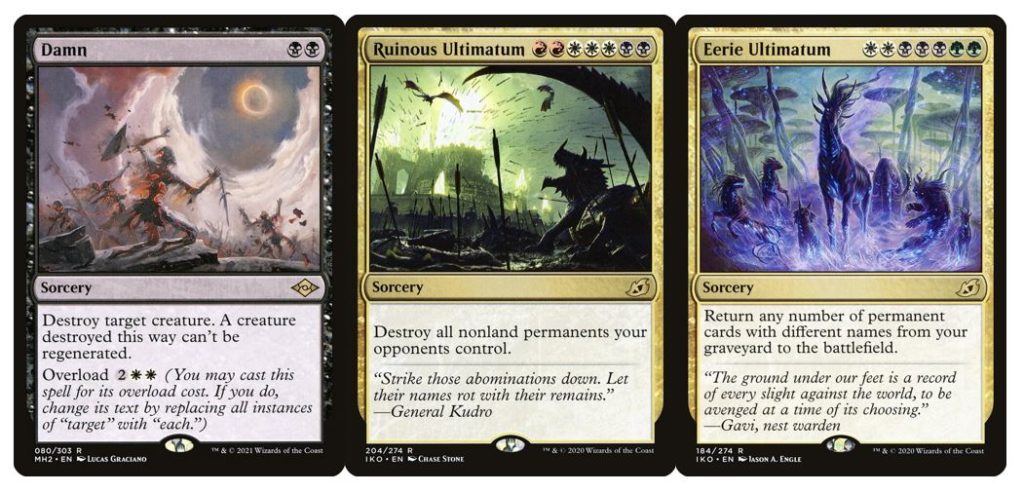
It’s no secret that sorceries are getting on our deck building shortlists again, and it’s because Wizards has really been ramping up their power level. In recent sets, the removal has improved significantly. Damn allows the choice between a Wrath of God or single target removal in one card; Ruinous Ultimatum is an asymmetrical sweeper of all the things; Eerie Ultimatum reanimates all the things. Though the power of these cards is reigned in somewhat by their sorcery-speed casting restrictions (and color requirements), they’re still benchmarks for the kinds of viable sorceries we need in Commander. Removal needs to be cheap and flexible like Damn or the new Rip Apart, and seven-mana spells need to create a huge tempo swing in order to be viable.
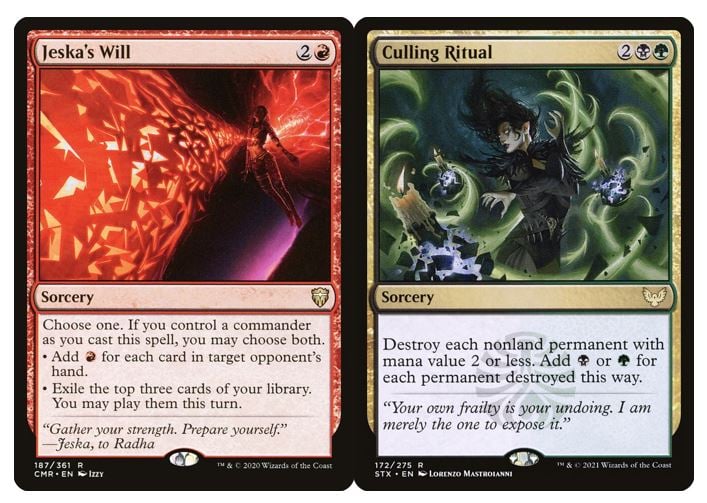
Sorceries aren’t only for removal or recursion, though. Some of the best mana generation in the game right now comes from sorcery spells. Both Jeska’s Will and Culling Ritual are big players in both cEDH and stronger EDH tables, and offer unparalleled resources that are format-contingent. They work for the same reason Dockside Extortionist works — multiplayer changes everything.
Midnight Hunt Has Great Sorceries
Vanquish the Horde
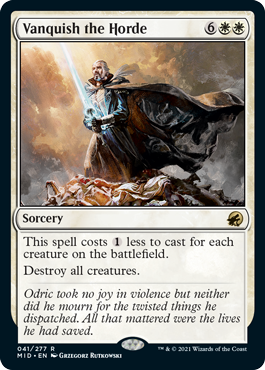
Midnight Hunt has some of the best sorcery spells we’ve seen for a while. Now that we’ve established what makes a sorcery viable in Commander, let’s start things off with a barnstomper of an example. Vanquish the Horde is a board wipe that costs generic mana to cast for every creature in play when it’s cast. Quite often in EDH, it’s going to cost a mere WW to cast.
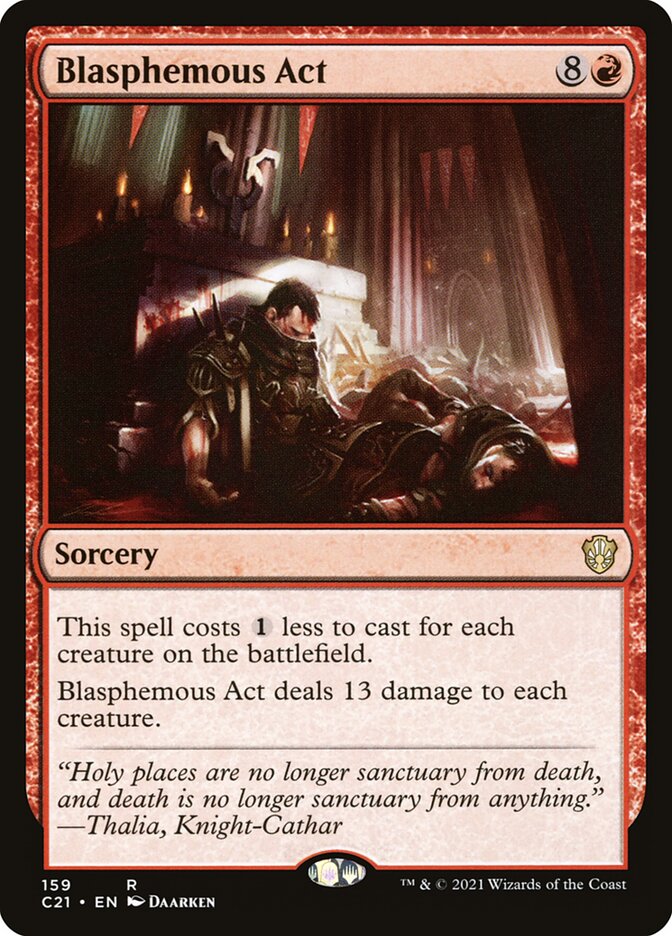
We’ve seen this effect before on Blasphemous Act — one of the biggest staples of the format, and a spell any red deck won’t leave the house without. What makes this so good is the ability to cast it and immediately be the first one to commit creatures to the board again. More expensive wraths can often mean you’re the last to commit to the board, so this is exactly the kind of spell that Commander needs. It’s exactly the kind of spell white needs, to be honest.
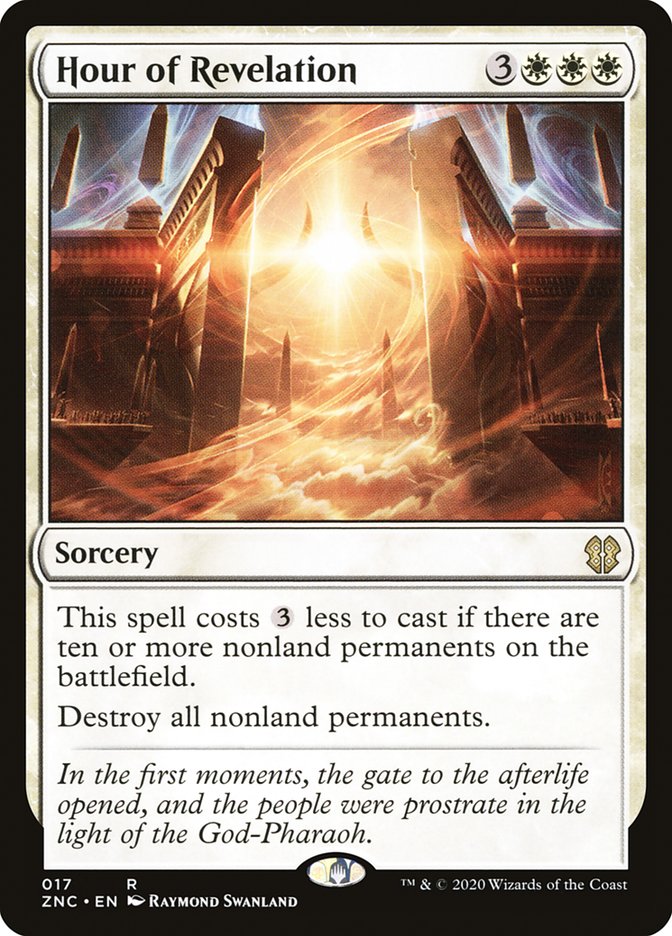
The most popular wraths that destroy all creatures are, unsurprisingly, the cheaper ones. Mono-white decks even love to play Hour of Revelation, given it can blow up all the things for only three mana a lot of the time.
Burn Down the House
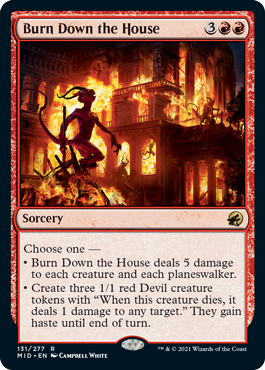
The other thing that wraths need to be is flexible. Like Damn or Austere Command, Burn Down the House acknowledges that pure damage wraths at sorcery speed don’t reeeeally cut it in red decks. If you load up on too many redundant versions of this effect that only wipe the board, you’ll have dead hands more often. If you open a pack of Midnight Hunt, watch out — you might get what you’re after. Even if turning the heat up to 365 degrees doesn’t work, perhaps making some blockers will help.
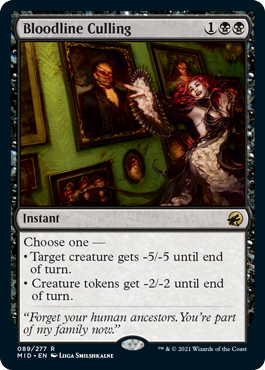
It’s far from the most powerful version of this effect, but having that extra mode makes it far more playable. The same is true for Bloodline Culling. Removing a creature with a -5/-5 can be achieved for just one mana with a Dismember, but Bloodline Culling also lets us wipe out tokens if we want to. While this spell is in fact an instant, it’s a good example of how good flexibility can be.
Ghouls’ Night Out

One from the Commander decks this time, Ghouls’ Night Out is incredible value for a five-mana sorcery. You get your pick of creatures from every player’s graveyard, including yours — which is better than Sepulchral Primordial at seven mana. The fact that creatures gain decayed is what allows this spell to be costed as it is, but it hardly matters if you can produce a winning board for five mana.
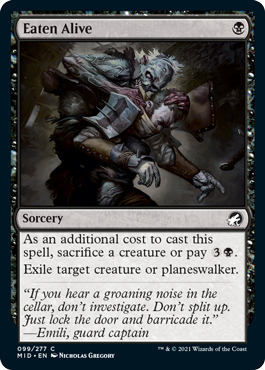
Spells are getting better, there’s no doubt about that. Eaten Alive is proof, and that might be enough to make this spell playable in Commander. “Exile” always trumps “destroy”; enough Aristocrats and tokens decks can put this card to work that it finally moves out of the “unplayable” list.
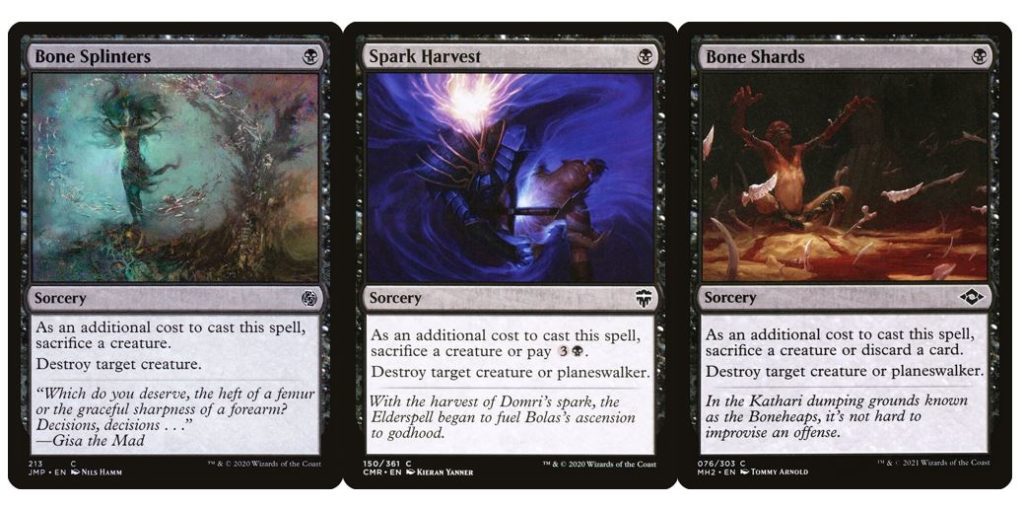
It’s been interesting to watch the evolution of Bone Splinters, and more interesting to me is how recently that evolution has occurred. With more card designs releasing than ever, we’re bound to see more experimentation with classic effects, which is a great way to introduce more competitive and powerful sorceries into the game.
Let’s face it — sometimes you can’t play at instant speed, anyway, because letting an opponent untap will give them mana to interact. There are just so many must-answer commanders these days.
Is Flashback the Key?
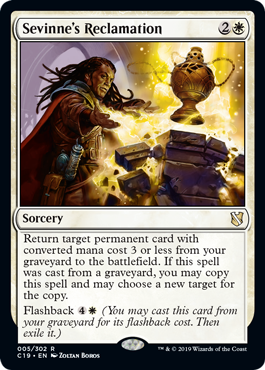
When I think about the best sorceries in recent years, I can’t get Sevinne’s Reclamation out of my mind. It’s a fantastic spell that gives a one-off Sun Titan effect, twice. White loves this effect, but there’s one big thing about this spell that makes it playable in Commander: flashback. In fact, if it didn’t have flashback? I don’t think it would be nearly as playable.
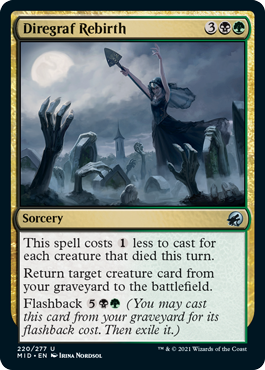
Enter Diregraf Rebirth. I want you to think about this spell as though it read “GB, Sorcery. Splice onto board wipe.”
Because that’s what it’s going to be most of the time, and I love it. It’s not limited to just casting in conjunction with board wipes, though; it’s a great tool for decks that like to sacrifice creatures, as it doesn’t care what died or how. Hell, just fire off a removal spell and play a Ravenous Chupacabra, then pay three mana to reanimate something else.
Flashback is a way to add power to cards in Commander, particularly because it’s a singleton format. Most cards are only cast once unless a specific piece of recursion allows a recast. While flexibility and modality is a surefire way to up the power level of a card, flashback might make less pushed sorceries more attractive to the average EDH player.
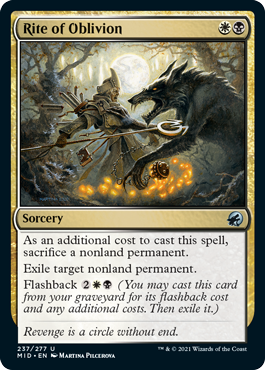
Consider Rite of Oblivion. Nobody plays much Utter End anymore, preferring instead a combination of Anguished Unmaking, Despark, and Vanishing Verse. Utter End is a little too expensive; holding up four mana is prohibitive now. Rite of Oblivion isn’t quite Utter End — it’s sorcery speed and requires sacrificing a creature to pull it off. Is it playable? Sure, in the right build. But barely — and to me, that’s really interesting. What pushes this card onto the radar is the flashback, and again, I think it’s a way to make cards more playable in Commander. Rite of Oblivion is fine in casual games, and comes pretty close to being playable at more tuned tables.
***
With all the emphasis on instant-speed interaction and protection, sometimes you gotta act before they untap. While instants are also usable in the main phase, you sometimes need the extra power that comes with a sorcery to get the job done. Sorceries are in an exciting place, and I can feel the potential for more interesting design space for EDH. Midnight Hunt has some great sorceries in particular, and I know I’ll be picking up a playset of Vanquish the Horde.
What are your favorite sorceries? Have any hidden gems? Let me know on Twitter.

Kristen is Card Kingdom’s Head Writer and a member of the Commander Format Panel. Formerly a competitive Pokémon TCG grinder, she has been playing Magic since Shadows Over Innistrad, which in her opinion, was a great set to start with. When she’s not taking names with Equipment and Aggro strategies in Commander, she loves to play any form of Limited.

